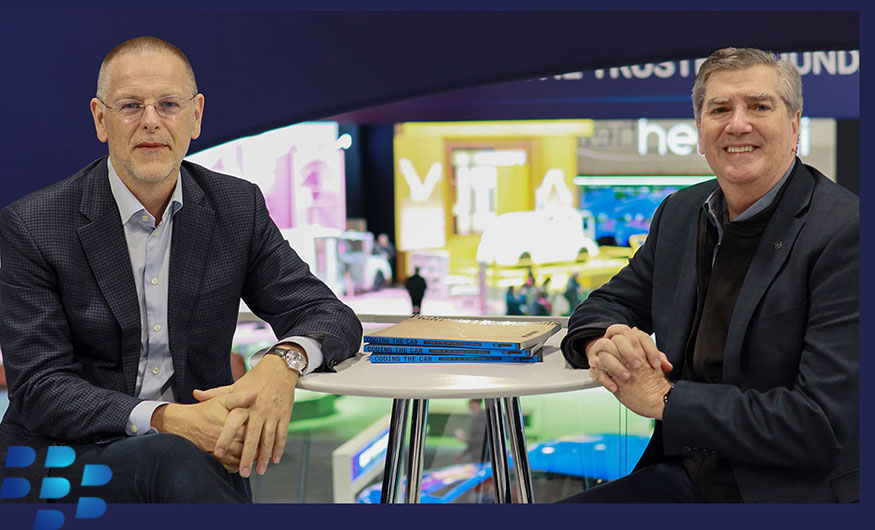QNX and the Importance of Edge Computing for Our Automotive Future

The software-defined vehicle (SDV) is the ultimate edge device: It fairly bristles with sensors, complexity, computational needs in abundance, and must also be as safe as possible. But scalable performance and security often seem to be mutually exclusive in computing, with robust dependability throttling speed and performance. Solving this problem for cars can serve as a model for edge technology, opening a gateway to achieving higher performance across a wide range of critical applications beyond the automotive realm.
Welcome to Season 3, Episode 1 of “Get In: The Software-Defined Vehicle Podcast From BlackBerry.“ This series explores the possibilities created by — and technologies behind — today’s revolution in global transportation. In this first episode of Season 3, we visit the Consumer Electronics Show® (CES) 2024 to talk to BlackBerry IoT President Mattias Eriksson about new advancements in delivering foundational software for the automotive edge, and how it’s allowing carmakers to design vehicles “better, faster and cheaper,” to meet market demands.
New QNX Release Powered by BlackBerry Innovations
Although BlackBerry is almost 40 years old, “The company has never been more at the cutting edge of technology,” Eriksson tells me during our conversation. “We have built products for customers that really need the highest performance, safety, and security for edge compute. That's the heart of our portfolio.”
At the very center of that portfolio is BlackBerry’s QNX® Software Development Platform (SDP) 8.0, which represents “a step change in performance and capabilities.” Just released for general availability in January 2024, “We created QNX SDP 8.0 to provide the highest safety and security at the edge,” Eriksson explains. “In the past, safety and security have always come at the price of performance. If you wanted to make it safe and secure, you had to make a trade-off somewhere else. Four years ago, we started the R&D to take that restriction away, which is what we've done with SDP 8.0.”
In fact, QNX now scales along with the advancing number of computing cores being deployed at the edge, giving carmakers “the capability in the software to take advantage of that compute power, but without compromising safety and security,” adds Eriksson.
QNX Beyond Cars
Automotive applications are perfectly suited for QNX, but Eriksson’s vision extends much further. “Several years ago, we decided very deliberately to focus on automotive, because we saw there was no other platform at the edge that had more compute, memory, connectivity, sensors, or complexity. The basic idea was that if you can serve the most complex use cases, that will spill over to other industries,” he says.
In addition, “We have customers across a broad range of the general embedded market (GEM), such as autonomy and robotics.” This includes robotics, vehicles of every description, and perhaps the largest market of all: industrial automation. “When you have the highest requirements for safety, security, reliability, and performance, that's when QNX is ideal.”
Connecting Edge Devices to the Cloud
The company is also expanding what’s possible — and scalable — for edge devices through its BlackBerry IVY® platform, which focuses on connecting edge computing systems to the cloud. “Increasing what you can do with the edge has reduced the need for connectivity, thanks to the compute performance in the car,” says Eriksson. “But cloud connectivity is very important. It's the foundation for most compute today.”
Helping automakers strike the right balance between edge and cloud computing is a key capability that IVY® provides. The profusion of sensors in modern cars may be able to generate terabytes of data per hour, far exceeding the practical limits for transmission to the cloud. “It's just too much data. There will be significantly more edge compute (power) for the next decade, but the cloud is also continuing to expand very heavily, and that's at the heart of this project that we have with Amazon Web Services (AWS).
“The whole idea of IVY was to take the best at the edge in terms of compute and capabilities, which is QNX, and the best in the cloud, which is arguably AWS, and you combine those two fundamental technology capabilities to offer a platform,” continues Eriksson. At CES this year, BlackBerry’s IoT division showcased an expanding list of use cases, design wins, and partners for IVY, demonstrating how this platform has matured since it first became commercially available last spring.
QNX and the Year Ahead
Looking forward to CES 2025, Eriksson sees an even brighter future for QNX. “This has been the biggest product launch year for us in a decade,” he notes, but it only represents a beginning. BlackBerry’s customers are already asking for more features and additional middleware layers. “We have started talking to many customers about expanding the ‘foundational software’ definition, adding more capabilities to the core OS. That ties nicely into the QNX® Everywhere program.” The program, which BlackBerry also announced during CES 2024, aims to make QNX® software and training easily accessible for academic and noncommercial uses, as a way to help address a global shortage of embedded software developers.
For Eriksson, it’s about “helping customers with their real problems.” Providing those solutions to complex problems offers ample opportunities for BlackBerry to continue to innovate in the year ahead. As a result, “There’s a lot to come, over the next 12 months.”
